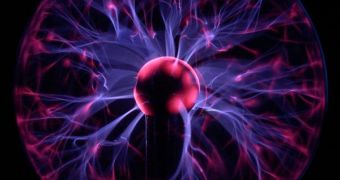Investigators from the DIII-D National Fusion Facility and the ASDEX Upgrade tokamak announce the creation of a new imaging technique that allows physicists to visualize alpha particles that ride Alfven waves inside nuclear fusion containment vessels.
Like surfers riding waves to the shoreline, alpha particles produced in immensely-hot plasma hitch a ride towards the walls of the containment vessels on high frequency Alfven waves they excite.
Understanding what happens to alpha particles is tremendously important, given that they help heat and maintain plasma temperatures to around 100 million degrees, enough to kick-start nuclear fusion.
One of the main problems experts have with doing so is that many of the particles escape on the waves, and exit the containment chamber. Reaching the temperatures required for fusion therefore becomes harder and more complex.
Inside fusion reactors, the hydrogen isotopes deuterium and tritium are generally used to obtain fusion. These chemicals need to be subjected to very high temperatures and pressures, in order to fuse together, and to start producing energy and helium.
Until recently, physicists had no way of determining how alpha particles riding Alfven waves looked like. The only possible visualization was that allowed by mathematical and physical models.
In the new investigation, the research team managed to provide the very firs two-dimensional visualization of the 3D patterns that alpha particles and the high-frequency waves produce as they are heading towards the walls of fusion reactors.
This was achieved through the use of a new, highly-sensitive camera, that is capable of detecting even the slightest temperature fluctuations taking place inside super-heated plasma.
Experts say that these variations are indicative of the passing of Alfven waves. These results will be presented on November 8, at the 52nd annual meeting of the American Physical Society Division of Plasma Physics, Science Blog reports.
Fusion energy is touted as our best option as a civilization in ensuring our future energy needs are met. Fossil fuels are clearly unsustainable to use, whereas solar and wind-based energy production methods are still very inefficient. Nuclear fission is too expensive and unsafe.
But nuclear fusion is a method that produces no harmful products, and which is capable of releasing more energy than is put into starting it once fusion is achieved.
As such, it could provide us with a long-lasting source of electricity, that would cover our needs, with plenty of extra energy to space.

 14 DAY TRIAL //
14 DAY TRIAL //